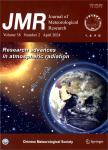An Attempt to Improve Kessler-Type Parameterization of Warm Cloud Microphysical Conversion Processes Using Cloud Sat Observations
An Attempt to Improve Kessler-Type Parameterization of Warm Cloud Microphysical Conversion Processes Using Cloud Sat Observations作者机构:State Key Laboratory of Severe WeatherChinese Academy of Meteorological Sciences Department of Earth ScienceZhejiang University
出 版 物:《Journal of Meteorological Research》 (气象学报(英文版))
年 卷 期:2015年第29卷第1期
页 面:82-92页
核心收录:
学科分类:07[理学] 070601[理学-气象学] 0706[理学-大气科学]
基 金:Supported by the National Natural Science Foundation of China(41405006) China Meteorological Administration Special Public Welfare Research Fund(GYHY201006014 and GYHY201306005) National(Key)Basic Research and Development(973)Program of China(2012CB417204) Basic Research Fund of the Chinese Academy of Meteorological Sciences(2014R016 and2014Z001)
主 题:autoconversion microphysical parameterization threshold of autoconversion
摘 要:Improvements to the Kessler-type parameterization of warm cloud microphysical conversion processes(also called autoconversion) are proposed based on a large number of Cloud Sat observations between June2006 and April 2011 over Asian land areas. The emphasis is given to the vertical distribution of liquid water content(LWC), particularly, the threshold values of LWC for autoconversion. The results warrant a new approach to the numerical parameterization of autoconversion in warm clouds. One feature of this new approach is that the autoconversion threshold, which has been treated as a constant in previous parameterization schemes, is diagnosed as a function of altitude by using a relationship between LWC and height(H)derived from Cloud Sat observations: LWCdig =-500.0 ln( H/9492.2). Under this framework, the threshold LWC decreases with increasing H, allowing autoconversion to occur in clouds with low LWC(approximately0.3 g m^-3) at levels above 5.5 km. Autoconversion rates calculated based on the new parameterization are compared to those calculated based on several commonly used parameterization schemes over a range of LWCs from 0.01 to 1.0 g m^-3. The new scheme provides reasonable simulations of autoconversion at various vertical levels.



